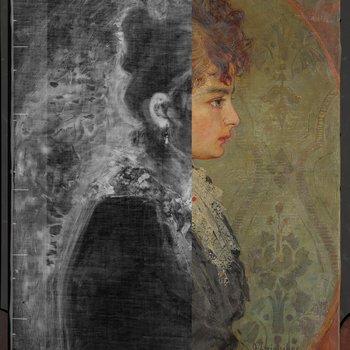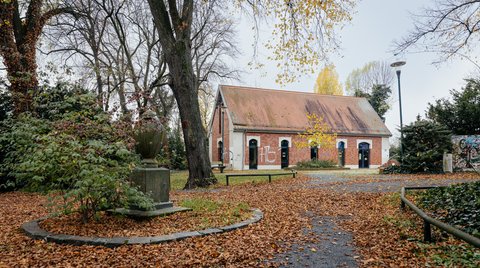
Die art Kapella in Schkeuditz © Staatliche Kunstsammlungen Dresden, Schenkung Sammlung Hoffmann, Foto: Oliver Killig
Having visited Sammlung Hoffmann in Berlin and taken part in a joint workshop with us, organised by Schenkung Sammlung Hoffmann, the curator of art Kapella Schkeuditz, Petra Kießling, selected one of the collection’s many works: the video piece “Met losse handen” (Hands free, 2004) by the Dutch artist Marijke van Warmerdam. In the exhibition room of the converted chapel at the Old Cemetery in Schkeuditz, the large windows offer a sweeping view of a landscape that came into the curator’s mind when watching the video.
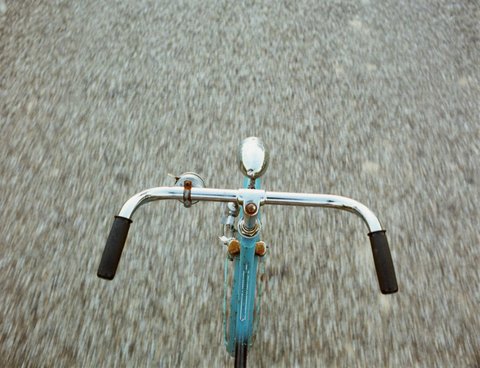
Filmstill aus Marijke van Warmerdams "Met losse handen", 2004 © Staatliche Kunstsammlungen Dresden, Schenkung Sammlung Hoffmann, Marijke van Warmerdam
“Met losse handen” (Hands free, 2004) takes us for a trip on a bicycle ridden by the artist with no hands. Through the lens of the camera, as the subject, we first concentrate on the handlebars and the speed at which the asphalt slips away beneath us. The camera then pans upwards, at first hesitantly, then with increasing confidence, taking our gaze to the side of the path, with the ditch typically found in Holland, before lifting off into the air, where our eyes start to spiral up a tree.
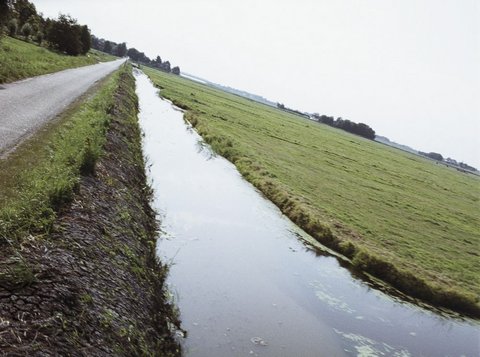
Filmstill aus Marijke van Warmerdams "Met losse handen", 2004 © Staatliche Kunstsammlungen Dresden, Schenkung Sammlung Hoffmann, Marijke van Warmerdam
By this point at the latest, we are starting to wonder why we have not fallen into the ditch some time ago, or if we are simply in a daydream. Absolute freedom thus seems to lie somewhere between control and daring; a carefree state verging upon risk-taking but also closely linked to deception and fantasy. The hook is the viewer’s surprise at the transition between reality and illusion. The artist Marijke van Warmerdam, who works with film and photography, often uses simple imagery employing stark colour compositions and duplicate or mirror images, addressing the viewer directly. Marijke van Warmerdam was born in 1965 in Nieuwer-Amstel, the Netherlands. From 1987 to 1990 she studied at the Rijksakademie van beeldende kunsten, Amsterdam. In 1995, she exhibited at the Dutch pavilion at the Biennale di Venezia. She lives and works in Amsterdam and Karlsruhe, Germany.
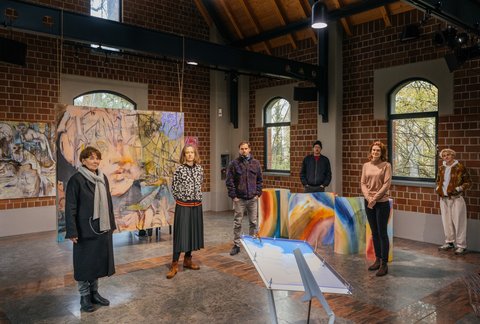
Die Künstler*innen mit der Kuratorin im Ausstellungsraum © Staatliche Kunstsammlungen Dresden, Schenkung Sammlung Hoffmann, Foto: Oliver Killig
The artists Nori Blume, Konrad Hanke, Markus Heller, Lisa Wölfel and Mihaela Vujnovic were invited to respond to the piece with their own powerful, sometimes visually intense works. The curator describes their artistic engagement with the piece as having been a particular challenge for the artists. Each of them dealt with the undertaking in their own entirely individual way. As Petra Kießling sees it, this reflects the simple, candid imagery found in Marijke van Warmerdam’s art, which emphasises the beauty of everyday actions.
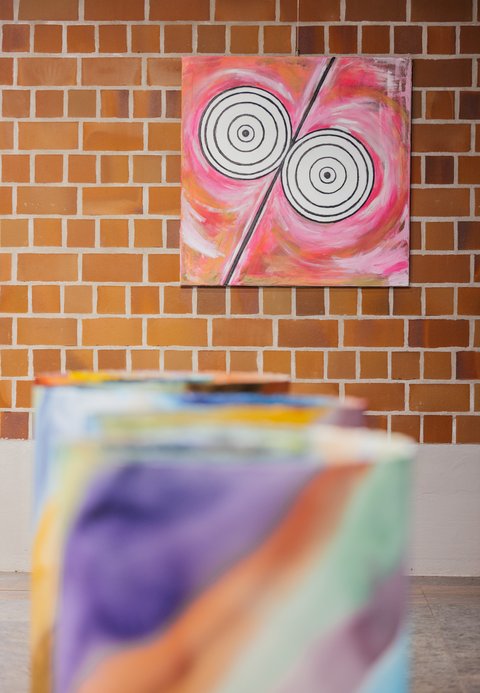
Nori Blume: art about art, 2022, Acryl und Ölkreide auf Leinwand, 89cm x 89 cm © Nori Blume, Foto: Oliver Killig
Nori Blume
“In my artistic response, I concentrated on the directions of the gaze in the video. A film cannot be understood from a single image, but in a work of art everything happens in a single moment, while time seems to stop in its tracks. The video ‘Met losse handen’ catapults the viewer onto a bicycle. As we watch the video, we appear to be riding it ourselves. We cycle with no hands on a smooth road, look once to the right and once to the left, and feel a pull that seems to go on forever. The straight line represents the balance holding the bike on the road and stopping us falling off. The circles expanding on the left and right are the view of the landscape, the sky and the trees. The movement of the viewer’s gaze forms a horizontal eight which, in turn, symbolises infinity.”
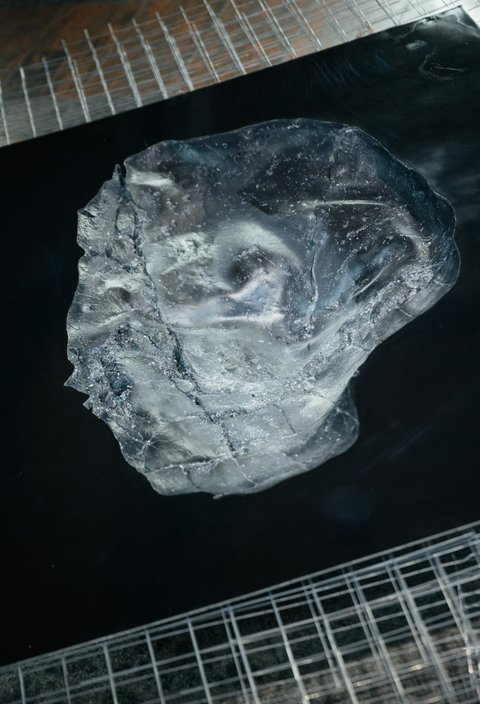
Konrad Hanke: Interception, 2022, Stahl, Epoxidharz, Lack 150 x 170 x 25 cm © Konrad Hanke, Foto: Oliver Killig
Konrad Hanke
“The first time I saw the video, I was bothered by its simplicity. One of my first reactions was to see a certain expression of irony in the contemplative journey the viewer’s gaze takes. My intuitive response was a need to be distracted by the details of the surroundings. I guess it is my own consumerist attitude that leads me to imagine a loud commentary behind this quiet communication. At the same time, my reaction to no-hands cycling is shaped by an experience that happened some time ago, but was quite unpleasant. So I wanted to pick up on the portrayal of the bike ride by depicting a pitted surface. To deal with my unease at the diffuse, contemplative moment as your gaze travels, I wanted to add an element that directly interrupts the endless cycle of the loop, while at the same time giving the piece a mirror finish as a nod to that loop.”
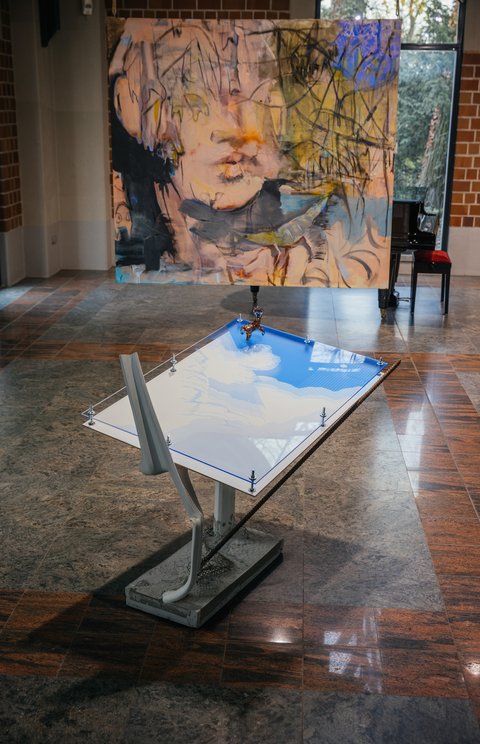
Markus Heller: Met grote ogen, 2022, UV-Print auf Acrylglas, Zement, Metall, Kunststoff, Holz, Keramik, ca. 110 cm x 80 cm x 80 cm © Markus Heller, Foto: Oliver Killig
Markus Heller
“The creation of my works and their content follows a process. The process of searching is always central to me. I come up with individual objects made from ceramics and found materials, then put them in new contexts in installations, which I then build upon in their turn. I develop digital graphics using the same principle of collecting and combining. Ceramics and clay are rudimentary, archaic materials just as raster graphics are a rudimentary form of digital graphics. I use these artistic media to approach the topics of the archaic, technology and human beings. What fascinates me about Marijke van Warmerdam’s video piece is the grace and weightlessness of the flying camera (which is also my eye as the viewer) and the brief, vertiginous disconnect I experience as I seem to take off from the moving bicycle and sail away into the clouds and landscape. In my work ‘Met grote ogen’, I transfer those impressions to my work process. The concrete and metal of the base, standing on the floor, represent the accident that is expected, but never happens in the video. The UV print on acrylic glass is connected to floating and the immaterial. The figure standing on the glass calls the meaning of the piece into question. Its starkly surprised expression ironically reflects the experience I had watching ‘Met losse handen’.”
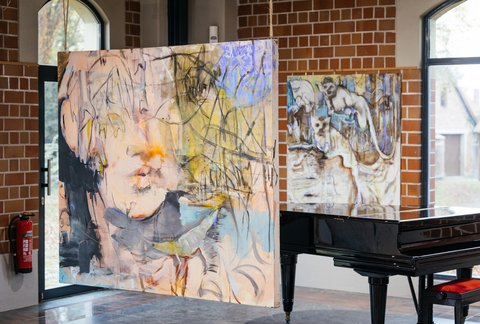
Lisa Wölfel: FLUX I & FLUX I, 2022, Tusche, Acryl, Kohle, Pastell, Ölkreide, Öl, Lack auf Baumwolle und Leinen, 188x170 cm, 160x160 cm © Lisa Wölfel, Foto: Oliver Killig
Lisa Wölfel
“The focus of my engagement with Marijke van Warmerdam’s video piece was on the gaze, which was all the more concentrated and serious for the fact that it wandered. I came on board the perception of the present captured in the video as a passenger: after many attempts to approach the subject through drawings, my focus settled on a piece that I created in parallel; a face disintegrating into plant and animal forms, that is simultaneously the foreground and background – a personal translation. When I concentrate hard on observing the natural world, my self-awareness can fade entirely into the background if I let it. Perhaps that’s rather like what the cyclist experiences in Warmerdam’s work. Some ‘stone animal clouds’ also came about, along with another image that was additionally influenced by watching squirrel monkeys at Leipzig Zoo. So the connecting element to ‘Met losse handen’ is the special form of concentration created by close observation. In general, I work a lot with memories, but also with inventions and subconscious ideas, always with the aim of achieving a certain atmospheric effect. That means I interweave existing and new elements, capturing them in images, sculptures or spatial settings. I work with a lot of movement and rhythmic activity, and regularly review my intuitive artistic choices.”
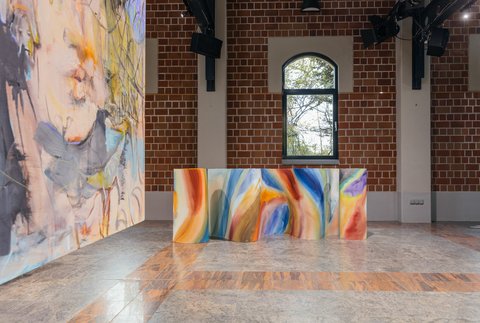
Ein Tag mehr...ein Tag weniger, 2022, Aquarell auf Papier, 240 x 90 cm, 900 x 90 cm (Gesamtmaß) © Mihaela Vujnovic, VG Bild-Kunst Bonn 2022, Foto: Oliver Killig
Mihaela Vujnovic
“The main inspiration for ‘One day more ... one day less’ is the connection between the past and the future, and with the present moment, which is the living link between those two opposite poles of our existence in time. This video, too, can be seen as comparing our life to a journey from one pole to the other. As we move from one unknown situation to another, we are travelling along a timeline we know in advance will come to an end. The imagined cyclist in the video seems to be following a specific path, but also wanders around aimlessly: their gaze strays from the road to the fields and trees. Similarly, our life often follows a set path, but we too stray from it, and our journeys take uncontrollable, illogical twists and turns, abounding with different landscapes, feelings, people and objects. Starting out from thoughts about movement, rotation, twists and turns, the road, time and the points that are the beginning and the end, I created a piece that is twisted into a spiral at either end. Those ends are the start and the finish (like the journey from the unknown past to the unknown future), and everything in between stands for the experiences we have in the course of our lives.”
Auch interessant:
Ortsgespräche ("Local CONVERSATIONS"): SCHENKUNG SAMMLUNG HOFFMANN IN DIALOGUE WITH Glauchau
With the "Ortsgespräche" series, the Schenkung Sammlung Hoffmann also makes itself available for art locations in the so-called rural areas of Saxony, where the diversity and social topicality of contemporary art is sometimes put up for discussion with particular vehemence. This October, this is being done in cooperation with art gluchowe e.V., the art association of the city of Glauchau:
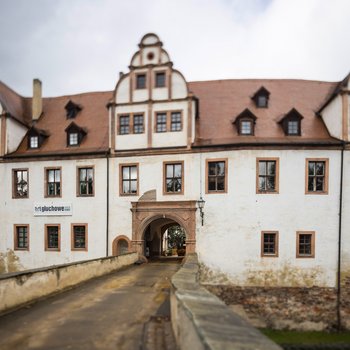
Message from Penelope
The scholarship of the German Academy of Rome also includes three-month stays at Casa Baldi in Olevano Romano, a small mountain town located about an hour southeast of Rome. The lyricist and philosopher Peter Neumann spent such a stay in 2021 and provided us with three of his texts, which were written around and about the Casa Baldi.
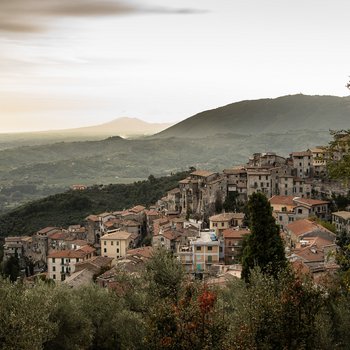
Oskar Zwintscher. The Unknown Masterpiece
Seventeen works from the artist’s oeuvre – which originally comprised around 150 paintings – were examined in the research project “Oskar Zwintscher (1870–1916). The Unknown Masterpiece” by the Staatliche Kunstsammlungen Dresden in the Albertinum, funded by the Friede Springer Stiftung, subjecting them to art technology analysis in the painting restoration workshop. Here you can gain insight into the complexity found in the structure of Oskar Zwintscher’s paintings.
